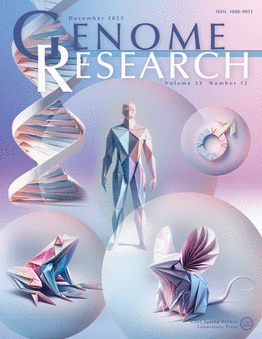Generation and analysis of a mouse multitissue genome annotation atlas
IF 6.2
2区 生物学
Q1 BIOCHEMISTRY & MOLECULAR BIOLOGY
引用次数: 0
Abstract
Generating an accurate and complete genome annotation for an organism is complex because the cells within each tissue can express a unique set of transcript isoforms from a unique set of genes. A comprehensive genome annotation should contain information on what tissues express what transcript isoforms at what level. This tissue-level isoform information can then inform a wide range of research questions as well as experiment designs. Long-read sequencing technology combined with advanced full-length cDNA library preparation methods has now achieved throughput and accuracy where generating these types of annotations is achievable. Here, we show this by generating a genome annotation of the mouse (Mus musculus). We used the nanopore-based R2C2 long-read sequencing method to generate 64 million highly accurate full-length cDNA consensus reads—averaging 5.4 million reads per tissue for a dozen tissues. Using the Mandalorion tool, we processed these reads to generate the Tissue-level Atlas of Mouse Isoforms which is available as a trackhub for the UCSC Genome Browser and contains at least one full-length isoform for the vast majority of expressed genes in each tissue.小鼠多组织基因组注释图谱的生成与分析
为生物体生成准确而完整的基因组注释非常复杂,因为每个组织内的细胞都可以表达来自一组独特基因的独特转录本异构体。全面的基因组注释应包含哪些组织在何种水平上表达何种转录本异构体的信息。这种组织级的同工酶信息可以为各种研究问题和实验设计提供依据。目前,长线程测序技术与先进的全长 cDNA 文库制备方法相结合,已经实现了生成这类注释的通量和准确性。在这里,我们通过生成小鼠(Mus musculus)的基因组注释来展示这一点。我们使用基于纳米孔的 R2C2 长读数测序方法生成了 6400 万个高精度的全长 cDNA 共识读数,平均每个组织有 540 万个读数。我们使用 Mandalorion 工具对这些读数进行处理,生成了组织级小鼠同工酶图谱,该图谱可作为 UCSC 基因组浏览器的跟踪集,包含每个组织中绝大多数表达基因的至少一种全长同工酶。
本文章由计算机程序翻译,如有差异,请以英文原文为准。
求助全文
约1分钟内获得全文
求助全文
来源期刊

Genome research
生物-生化与分子生物学
CiteScore
12.40
自引率
1.40%
发文量
140
审稿时长
6 months
期刊介绍:
Launched in 1995, Genome Research is an international, continuously published, peer-reviewed journal that focuses on research that provides novel insights into the genome biology of all organisms, including advances in genomic medicine.
Among the topics considered by the journal are genome structure and function, comparative genomics, molecular evolution, genome-scale quantitative and population genetics, proteomics, epigenomics, and systems biology. The journal also features exciting gene discoveries and reports of cutting-edge computational biology and high-throughput methodologies.
New data in these areas are published as research papers, or methods and resource reports that provide novel information on technologies or tools that will be of interest to a broad readership. Complete data sets are presented electronically on the journal''s web site where appropriate. The journal also provides Reviews, Perspectives, and Insight/Outlook articles, which present commentary on the latest advances published both here and elsewhere, placing such progress in its broader biological context.
 求助内容:
求助内容: 应助结果提醒方式:
应助结果提醒方式:


